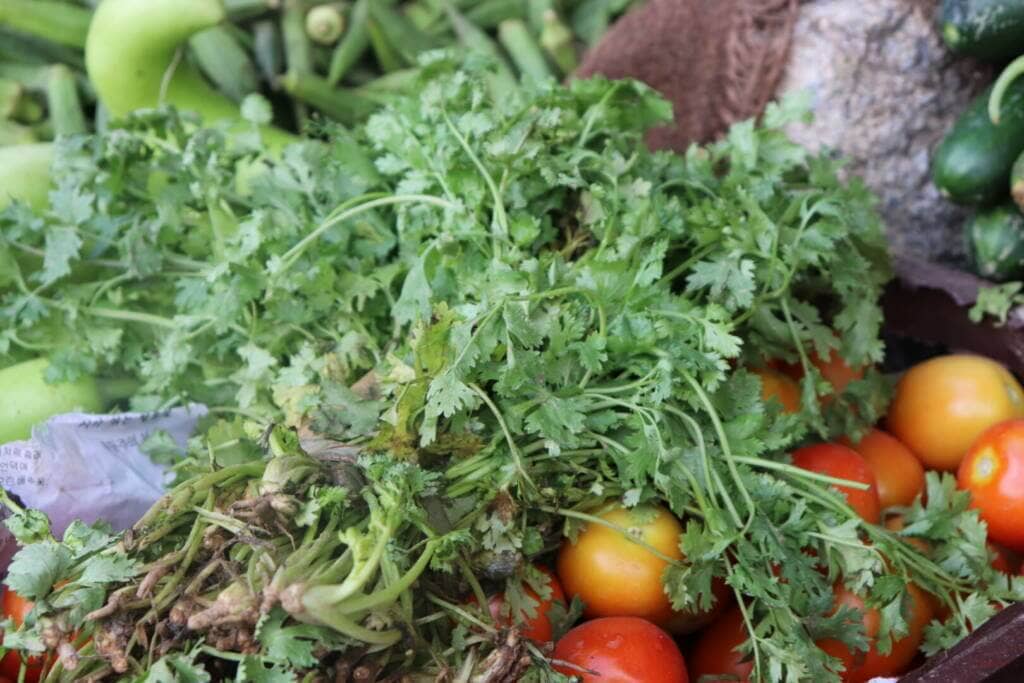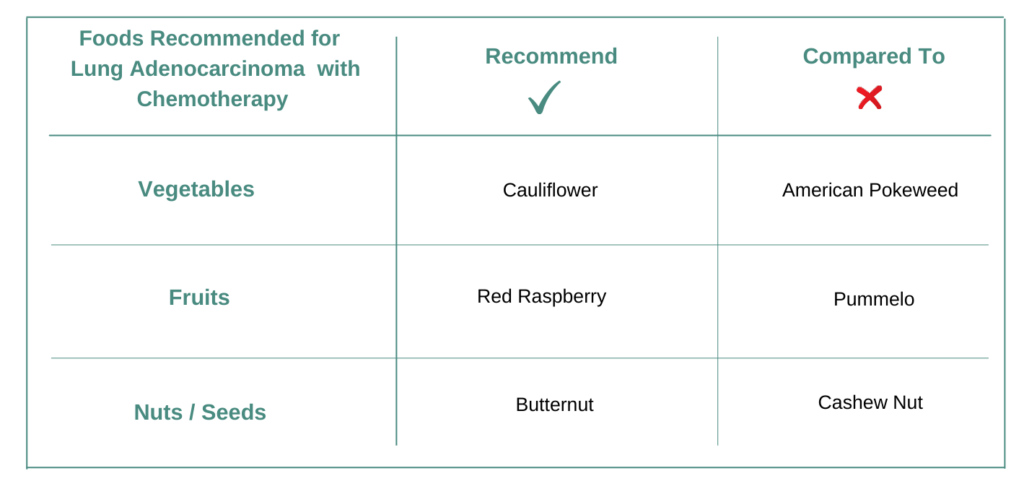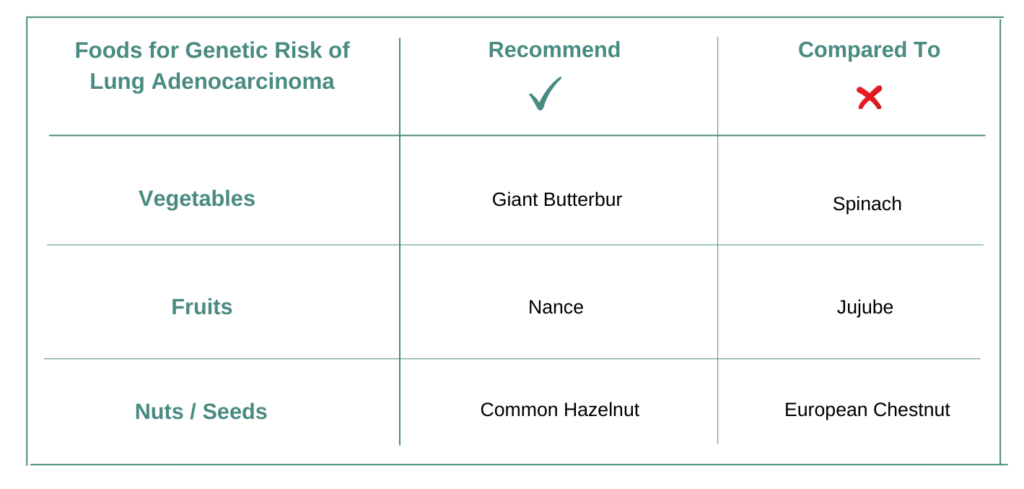Introduction
Foods for Lung Adenocarcinoma should be personalized for each individual and also must adapt when cancer treatment or tumor genetic change. The personalization and adaptation must consider all the active ingredients or bioactives contained in different foods with respect to cancer tissue biology, genetics, treatments, lifestyle conditions and diet preferences. Hence while nutrition is one of the very important decisions for a cancer patient and individual at risk of cancer to make – how to choose foods to eat is not an easy task.
Lung adenocarcinoma is the most common primary lung cancer comprising about 40% of all lung cancers. It is part of the non-small cell lung cancer (NSCLC) and has a strong association with previous smoking. While incidence and mortality have declined, lung adenocarcinoma remains the leading cause of death in the United States. It is the most common subtype of lung cancer to be diagnosed in people who have never smoked. The main risk factor for any lung cancer including lung adenocarcinoma, is smoking tobacco. Despite new treatments, the 5-year survival rate of lung adenocarcinoma is less than 12-15%. Based on its spread, it is classified into 4 types: adenocarcinoma in situ (AIS), minimally invasive adenocarcinoma (MIA), invasive adenocarcinoma, and variants of adenocarcinoma. AIS and MIA have better outcomes when resected early. Symptoms of lung cancer include a persistent cough, coughing up blood, even a small amount, shortness of breath, chest pain, hoarseness, weight loss, bone pain and headache. Treatment options for lung adenocarcinoma include surgery, radiation therapy, chemotherapy, immunotherapy, and targeted therapy. In addition, supportive care with complementary nutrition, foods, herbs and natural supplements, can help improve patients’ well being.
For Lung Adenocarcinoma does it matter what vegetables, fruits, nuts, seeds one eats?
A very common nutrition question asked by cancer patients and individuals at-genetic risk of cancer is – for cancers like Lung Adenocarcinoma does it matter what foods I eat and which I do not? Or if I follow a plant-based diet is that enough for cancer like Lung Adenocarcinoma?
For example does it matter if vegetable Cauliflower is consumed more compared to American Pokeweed? Does it make any difference if fruit Pummelo is preferred over Red Raspberry? Also if similar choices are made for nuts/seeds like Butternut over Cashew Nut and for pulses like Chickpea over Catjang Pea. And if what I eat matters – then how does one identify foods which are recommended for Lung Adenocarcinoma and is it the same answer for everyone with the same diagnosis or genetic risk?
Yes! Foods you eat matters for Lung Adenocarcinoma!
Food recommendations may not be the same for everyone and can be different even for the same diagnosis and genetic risk.

All foods (vegetables, fruits, nuts, seeds, pulses, oils etc.) and nutritional supplements are made up of more than one active molecular ingredient or bio-actives in different proportions and quantities. Each active ingredient has a unique mechanism of action – which can be activation or inhibition of different biochemical pathways. Simply stated foods and supplements which are recommended are those which do not cause an increase of molecular drivers of cancer but reduce them. Else those foods should not be recommended. Foods contain multiple active ingredients – hence when evaluating foods and supplements you need to consider the impact of all active ingredients cumulatively rather than individually.
For example Pummelo contains active ingredients Quercetin, Curcumin, Apigenin, Lupeol, Formononetin. And Red Raspberry contains active ingredients Quercetin, Ellagic Acid, Curcumin, Lupeol, Formononetin and possibly others.
A common mistake made when deciding and choosing foods to eat for Lung Adenocarcinoma – is to evaluate only selected active ingredients contained in foods and ignore the rest. Because different active ingredients contained in foods may have opposing effects on cancer drivers – you cannot cherry pick active ingredients in foods and supplements for making a nutrition decision for Lung Adenocarcinoma.
YES – FOOD CHOICES MATTER FOR CANCER. NUTRITION DECISIONS MUST CONSIDER ALL ACTIVE INGREDIENTS OF FOODS.
Skills Needed for Nutrition Personalization for Lung Adenocarcinoma?
Personalized nutrition for cancers like Lung Adenocarcinoma consists of recommended foods / supplements; not recommended foods / supplements with example recipes which prioritize use of recommended foods. An example of personalized nutrition can be seen at this link.
Deciding which foods are recommended or not is extremely complicated, requiring expertise in Lung Adenocarcinoma biology, food science, genetics, biochemistry along with good understanding of how cancer treatments work and associated vulnerabilities by which the treatments could stop being effective.
MINIMUM KNOWLEDGE EXPERTISE NEEDED FOR NUTRITION PERSONALIZATION FOR CANCER ARE: CANCER BIOLOGY, FOOD SCIENCE, CANCER TREATMENTS AND GENETICS.
Foods to Eat After Cancer Diagnosis!
No two cancers are the same. Go beyond the common nutrition guidelines for everyone and make personalized decisions about food and supplements with confidence.
Characteristics of cancers like Lung Adenocarcinoma
All cancers like Lung Adenocarcinoma can be characterized by a unique set of biochemical pathways – the signature pathways of Lung Adenocarcinoma. Biochemical pathways like Cell Cycle, MAPK Signaling, PI3K-AKT-MTOR Signaling, Extracellular Matrix Remodelling are part of the signature definition of Lung Adenocarcinoma. Each individual’s cancer genetics can be different and hence their specific cancer signature could be unique.
The treatments which are effective for Lung Adenocarcinoma need to be cognizant of the associated signature biochemical pathways for each cancer patient and individual at genetic risk. Therefore different treatments with different mechanisms of actions are effective for different patients. Similarly and for the same reasons foods and supplements need to be personalized for each individual. Hence some foods and supplements are recommended for Lung Adenocarcinoma when taking cancer treatment Somatostatin, and some foods and supplements are not recommended.
Sources like cBioPortal and many others provide population representative patient anonymized data from clinical trials for all cancer indications. This data consists of clinical trial study details like sample size / number of patients, age groups, gender, ethnicity, treatments, tumor site and any genetic mutations.
EGFR, TP53, MUC16, RYR2 and KRAS are the top ranked reported genes for Lung Adenocarcinoma. EGFR is reported in 9.0 % of the representative patients across all clinical trials. And TP53 is reported in 7.2 %. The combined population patient data cover ages from 9 to 93. 43.0 % of the patient data are identified as men. The Lung Adenocarcinoma biology along with reported genetics together define the population represented signature biochemical pathways for this cancer. If the individual cancer tumor genetics or genes contributing to the risk are also known then that should also be used for nutrition personalization.
NUTRITION CHOICES SHOULD MATCH WITH EACH INDIVIDUAL’S CANCER SIGNATURE.
Food and Supplements for Lung Adenocarcinoma
For Cancer Patients
Cancer patients on treatment or on palliative care need to make decisions on food and supplements – for the needed dietary calories, for managing any treatment side effects and also for improved cancer management. All plant-based foods are not equal and choosing and prioritizing foods which are personalized and customized to ongoing cancer treatment is important and complicated. Here are some examples providing guidelines for making nutrition decisions.
Choose Vegetable CAULIFLOWER or AMERICAN POKEWEED?
Vegetable Cauliflower contains many active ingredients or bioactives such as Curcumin, Lupeol, Formononetin, Isoliquiritigenin, Genistein. These active ingredients manipulate various biochemical pathways like MAPK Signaling, Cell Cycle, Growth Factor Signaling and PI3K-AKT-MTOR Signaling and others. Cauliflower is recommended for Lung Adenocarcinoma when ongoing cancer treatment is Somatostatin. This is because Cauliflower modifies those biochemical pathways which have been scientifically reported to sensitize the effect of Somatostatin.
Some of the active ingredients or bioactives in vegetable American Pokeweed are Quercetin, Curcumin, Apigenin, Lupeol, Formononetin. These active ingredients manipulate various biochemical pathways like MAPK Signaling, Oncogenic Cancer Epigenetics and PI3K-AKT-MTOR Signaling and others. American Pokeweed is not recommended for Lung Adenocarcinoma when ongoing cancer treatment is Somatostatin because it modifies those biochemical pathways which make the cancer treatment resistant or less responsive.
VEGETABLE CAULIFLOWER IS RECOMMENDED OVER AMERICAN POKEWEED FOR Lung Adenocarcinoma AND TREATMENT Somatostatin.
Choose Fruit RED RASPBERRY or PUMMELO?
Fruit Red Raspberry contains many active ingredients or bioactives such as Quercetin, Ellagic Acid, Curcumin, Lupeol, Formononetin. These active ingredients manipulate various biochemical pathways like MAPK Signaling, Cell Cycle, Angiogenesis and PI3K-AKT-MTOR Signaling and others. Red Raspberry is recommended for Lung Adenocarcinoma when ongoing cancer treatment is Somatostatin. This is because Red Raspberry modifies those biochemical pathways which have been scientifically reported to sensitize the effect of Somatostatin.
Some of the active ingredients or bioactives in fruit Pummelo are Quercetin, Curcumin, Apigenin, Lupeol, Formononetin. These active ingredients manipulate various biochemical pathways like WNT Beta Catenin Signaling and others. Pummelo is not recommended for Lung Adenocarcinoma when ongoing cancer treatment is Somatostatin because it modifies those biochemical pathways which make the cancer treatment resistant or less responsive.
FRUIT RED RASPBERRY IS RECOMMENDED OVER PUMMELO FOR Lung Adenocarcinoma AND TREATMENT Somatostatin.
Choose Nut BUTTERNUT or CASHEW NUT?
Butternut contains many active ingredients or bioactives such as Curcumin, Apigenin, Lupeol, Formononetin, Isoliquiritigenin. These active ingredients manipulate various biochemical pathways like MAPK Signaling, Cell Cycle, JAK-STAT Signaling and PI3K-AKT-MTOR Signaling and others. Butternut is recommended for Lung Adenocarcinoma when ongoing cancer treatment is Somatostatin. This is because Butternut modifies those biochemical pathways which have been scientifically reported to sensitize the effect of Somatostatin.
Some of the active ingredients or bioactives in Cashew Nut are Quercetin, Curcumin, Lupeol, Formononetin, Isoliquiritigenin. These active ingredients manipulate various biochemical pathways like MAPK Signaling, Growth Factor Signaling, Oncogenic Cancer Epigenetics and PI3K-AKT-MTOR Signaling and others. Cashew Nut is not recommended for Lung Adenocarcinoma when ongoing cancer treatment is Somatostatin because it modifies those biochemical pathways which make the cancer treatment resistant or less responsive.
BUTTERNUT IS RECOMMENDED OVER CASHEW NUT FOR Lung Adenocarcinoma AND TREATMENT Somatostatin.

For Individuals with Genetic Risk of Cancer
The question asked by individuals who have genetic risk of Lung Adenocarcinoma or familial history is “What Should I Eat Differently from Before?” and how they should choose foods and supplements to manage risks of the disease. Since for cancer risk there is nothing actionable in terms of treatment – decisions of foods and supplements become important and one of the very few actionable things which can be done. All plant-based foods are not equal and based on identified genetics and pathway signature – the choices of food and supplements should be personalized.
Choose Vegetable GIANT BUTTERBUR or SPINACH?
Vegetable Giant Butterbur contains many active ingredients or bioactives such as Curcumin, Apigenin, Delphinidin, Lycopene, Formononetin. These active ingredients manipulate various biochemical pathways like MAPK Signaling, PI3K-AKT-MTOR Signaling, RAS-RAF Signaling and Oxidative Stress and others. Giant Butterbur is recommended for risk of Lung Adenocarcinoma when associated genetic risk is EGFR. This is because Giant Butterbur increases those biochemical pathways which counteract the signature drivers of it.
Some of the active ingredients or bioactives in vegetable Spinach are Curcumin, Apigenin, Quercetin, Delphinidin, Formononetin. These active ingredients manipulate various biochemical pathways like Oxidative Stress and others. Spinach is not recommended when risk of Lung Adenocarcinoma when associated genetic risk is EGFR because it increases the signature pathways of it.
VEGETABLE GIANT BUTTERBUR IS RECOMMENDED OVER SPINACH FOR EGFR GENETIC RISK OF CANCER.
Choose Fruit NANCE or JUJUBE?
Fruit Nance contains many active ingredients or bioactives such as Curcumin, Apigenin, Delphinidin, Formononetin, Lupeol. These active ingredients manipulate various biochemical pathways like MAPK Signaling, PI3K-AKT-MTOR Signaling, RAS-RAF Signaling and Oxidative Stress and others. Nance is recommended for risk of Lung Adenocarcinoma when associated genetic risk is EGFR. This is because Nance increases those biochemical pathways which counteract the signature drivers of it.
Some of the active ingredients or bioactives in fruit Jujube are Curcumin, Apigenin, Quercetin, Delphinidin, Lycopene. These active ingredients manipulate various biochemical pathways like MAPK Signaling, Oxidative Stress and PI3K-AKT-MTOR Signaling and others. Jujube is not recommended when risk of Lung Adenocarcinoma when associated genetic risk is EGFR because it increases the signature pathways of it.
FRUIT NANCE IS RECOMMENDED OVER JUJUBE FOR EGFR GENETIC RISK OF CANCER.
Choose Nut COMMON HAZELNUT or EUROPEAN CHESTNUT?
Common Hazelnut contains many active ingredients or bioactives such as Curcumin, Quercetin, Delphinidin, Lycopene, Formononetin. These active ingredients manipulate various biochemical pathways like MAPK Signaling, PI3K-AKT-MTOR Signaling, RAS-RAF Signaling and Oxidative Stress and others. Common Hazelnut is recommended for risk of Lung Adenocarcinoma when associated genetic risk is EGFR. This is because Common Hazelnut increases those biochemical pathways which counteract the signature drivers of it.
Some of the active ingredients or bioactives in European Chestnut are Ellagic Acid, Curcumin, Apigenin, Quercetin, Delphinidin. These active ingredients manipulate various biochemical pathways like Oxidative Stress and others. European Chestnut is not recommended when risk of Lung Adenocarcinoma when associated genetic risk is EGFR because it increases the signature pathways of it.
COMMON HAZELNUT IS RECOMMENDED OVER EUROPEAN CHESTNUT FOR EGFR GENETIC RISK OF CANCER.

In Conclusion
Foods and Supplements chosen are important decisions for cancers like Lung Adenocarcinoma. Lung Adenocarcinoma patients and individuals with genetic-risk always have this question: “What foods and nutritional supplements are recommended for me and which are not?” There is a common belief which is a misconception that all plant-based foods could be beneficial or not but would not be harmful. Certain foods and supplements can interfere with cancer treatments or promote molecular pathway drivers of cancer.
There are different types of cancer indications like Lung Adenocarcinoma, each with different tumor genetics with further genomic variations across each individual. Further every cancer treatment and chemotherapy has a unique mechanism of action. Each food like Cauliflower contains various bioactives in different quantities, which have an impact on different and distinct sets of biochemical pathways. The definition of personalized nutrition is individualized food recommendations for the cancer indication, treatments, genetics, lifestyle and other factors. Nutrition personalization decisions for cancer require knowledge of cancer biology, food science and an understanding of different chemotherapy treatments. Finally when there are treatment changes or new genomics is identified – the nutrition personalization needs re-evaluation.
The addon nutrition personalization solution makes the decision making easy and removes all the guesswork in answering the question, “What foods should I choose or not choose for Lung Adenocarcinoma?”. The addon multi-disciplinary team includes cancer physicians, clinical scientists, software engineers and data scientists.
Personalized Nutrition for Cancer!
Cancer changes with time. Customize and modify your nutrition based on cancer indication, treatments, lifestyle, food preferences, allergies and other factors.
References
- Luad Mskimpact 2021
- Pan-cancer analysis of whole genomes.
- Protective versus promotional effects of white tea and caffeine on PhIP-induced tumorigenesis and beta-catenin expression in the rat.
- Brassinin inhibits STAT3 signaling pathway through modulation of PIAS-3 and SOCS-3 expression and sensitizes human lung cancer xenograft in nude mice to paclitaxel.
- Growth stimulation of human pulmonary adenocarcinoma cells and small airway epithelial cells by beta-carotene via activation of cAMP, PKA, CREB and ERK1/2.
- Inhibitory effect of Hibiscus protocatechuic acid on tumor promotion in mouse skin.
- Lycopene Inhibits Activation of Epidermal Growth Factor Receptor and Expression of Cyclooxygenase-2 in Gastric Cancer Cells.
- https://www.mayoclinic.org/diseases-conditions/lung-cancer/symptoms-causes/syc-20374620
- https://www.ncbi.nlm.nih.gov/books/NBK519578
